A1: Indigenous Peoples: A Brief History
For many of us, information contained in history books is considered an accurate reflection of our past. But what happens when that information is not factual or true? What happens when history reflects the perspective of “those who held the most power [and] chose the stories that were to become a part of history” (Johnson, n.d., para 2). What happens when history is used as a tool of the powerful to justify and retain power? Canadian history, as told by history books, has “discounted, ignored, and erased from history” (Johnson, n.d., para 2) the existence and contributions of Indigenous peoples. This chapter looks to the seldom acknowledged vibrant life being lived on Turtle Island long before colonization by Europeans. If we are to understand the present, it is important to have more than the colonizers’ version of history.
Pre-Colonial Contact
Typically, for decades, the Canadian history shared and taught began with colonization — with explorers and adventurers discovering a vast land that was sparsely populated by savages. Thankfully, that narrative is beginning to change. What can be said though with certainty about what life was like on Turtle Island before colonization?
Given the vastness and climate diversity of the land now known as Canada, it is important to consider how the way of life would have differed for people living in different regions of this land. One of the things that would have been common though is a connection to water not just for survival, but as a significant cultural signifier. The traditions and ways of life of the many nations across Turtle Island were influenced by the water features near them.
A lot of what is known about the way of life on Turtle Island pre-contact comes from the archeological evidence, but also from the journals and reports of the early colonists. We know that plants were being used for medicinal purposes, maple sugaring was common, and corn, beans, squash, rice, and other vegetables were being harvested.
Pan-Indigenizing, making overarching statements that apply to all Indigenous people, is problematic. This is especially the case when it comes to governance and leadership. From the stories and traditions that have been passed down, some communities were hierarchical, either with patriarchal or matriarchal leadership, while others relied solely on the circle governance model of all voices being heard in decision-making. It is also known that Two-Spirit people were highly revered and looked to for guidance as they hold the gifts of both genders and can see things from more than one gender viewpoint.
One final element of life to mention here is that of cooperation and sharing. Many alliances, confederacies, and treaties between nations were held long before colonization. These were always undertaken in the spirit of cooperation, the sharing of resources, trade, and peace.
For a detailed look at what is known about the way of life pre-contact, see: The Standard of Living Before European Settlement.
PBS aired a four-episode series called Native America that examines the way of life in the Americas before colonization. While heavily focused on the United States and South America, much can be learned about the history of the land we are presently on through this series. You can access the series through clips provided on the Native America in the Classroom website.
Colonial History and Legacy
It is important to understand that the history of colonization begins with rather peaceful and mutually beneficial interactions between Europeans and First Nations and Inuit populations. During first contact, Europeans relied on Indigenous people for successful trade and even survival. Early on there was an agreement between Indigenous people and Europeans to share the land. Both parties could see the mutual benefits of their trade relationship. This posture of friendship by Europeans was a facade used to win over trust in order to establish invasive strategies to displace Indigenous people.
A key strategy in the domination of Turtle Island is the Doctrine of Discovery; a doctrine of superiority that legitimized the colonization of sovereign Indigenous nations globally in the name of Christianity. This global take-over included the land of Indigenous people in what is now Canada.
The Doctrine of Discovery claimed that if land was vacant, it could be claimed by explorers in the name of the Monarchy. Since Indigenous people were non-Christian this meant they were less than human (savages), and therefore since the land was uninhabited by humans, Christian Europeans had the right to colonize whatever land they discovered.
The notion of terra nullius, meaning empty land, was also used to legitimize colonization. If the land was empty of humans, it was free for the taking. Since Indigenous people were non-Christian, they were uncivilized, nonhuman, or savage, and therefore the land was terra nullius and taking it was justified.
The Royal Proclamation
The Royal Proclamation of 1763 is a document that outlined European settlement of Indigenous land. King George III issued this document to provide guidelines of how Britain could claim territory. While much of the language in the Royal Proclamation of 1763 can be difficult to understand, the essence of the Proclamation is that Indigenous rights and territory are recognized by the Crown (at the time the British King but now the federal government). The Proclamation acknowledges that Indigenous title to land will continue to exist and that it would continue to exist as such unless ceded by a treaty. At the time, it was only the Crown that could purchase land and anyone that wished to buy land had to buy it from the Crown.
Although the Proclamation promises protection of Indigenous lands (when the proclamation states: their land shall never be molested or disturbed), this is still a colonial document that establishes a colonial view of land as possession. Also, it is a document that was created without the consultation of Indigenous peoples.
The Royal Proclamation of 1763 is still a legitimate official document. Despite this, the settlement of Europeans began to grow in numbers, mostly without consultation or negotiation with Indigenous peoples of the territory. Sometimes, however, treaties were established between Indigenous peoples and the government to ensure Indigenous people were compensated for the land taken, although the fairness of these treaties are contested.
The following video provides an overview of the Royal Proclamation of 1763 and its impact.
The Indian Act
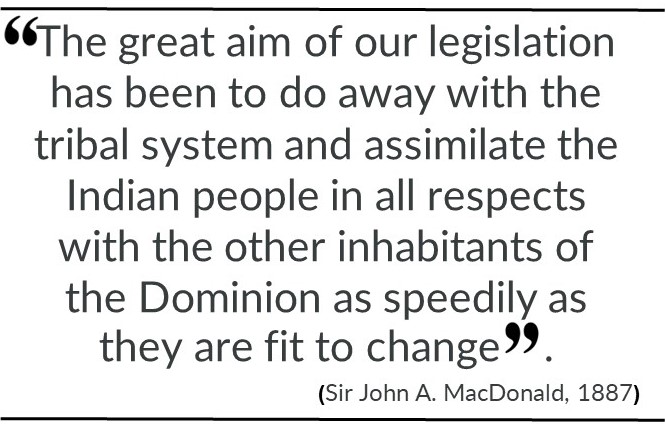 Although Indigenous people had laws that were established long before colonization, the federal government wanted a more structured relationship of control over them, their communities, lands, and resources. The Indian Act was created with the purpose of assimilating First Nations people into European-Canadian society. The Indian Act has been historically discriminatory and oppressive, which has contributed to several violations of human rights. Many amendments have been made to the Act over the years but it is still a current piece of legislation used to outline various rules and regulations involving reserve land, governmental responsibilities of band councils, and other aspects of life for Indians with status. It is the Indian Act that defines who can and cannot acquire status.
Although Indigenous people had laws that were established long before colonization, the federal government wanted a more structured relationship of control over them, their communities, lands, and resources. The Indian Act was created with the purpose of assimilating First Nations people into European-Canadian society. The Indian Act has been historically discriminatory and oppressive, which has contributed to several violations of human rights. Many amendments have been made to the Act over the years but it is still a current piece of legislation used to outline various rules and regulations involving reserve land, governmental responsibilities of band councils, and other aspects of life for Indians with status. It is the Indian Act that defines who can and cannot acquire status.
For more information on the Indian Act, visit the webpage 21 Things You May Not Have Known About the Indian Act and read the list.
Treaties
Intent
The traditions and protocols of Indigenous treaties existed long before first contact with Europeans. Indigenous people had engaged in their own forms of governance for hundreds of years; sharing resources and building alliances between nations. For First Nations people, treaties are considered sacred. To honour their sacredness, protocols and negotiations involved ceremonial aspects such as a pipe ceremony or an exchange of symbolic items.
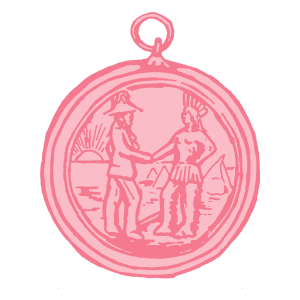
The peaceful and harmonious alliances between Indigenous groups that were formed hundreds of years ago still exist today. One of the most well-known examples of this is the Haudenosaunee Confederacy (also known as Six Nations or Iroquois Confederacy) and is considered the first democracy. The Haudenosaunee includes Mohawk, Oneida, Onondaga, Cayuga, and Seneca, and later included Tuscarora. There is also the Three Fires Confederacy beginning in the 1600s that is made up of Ojibway, Potawatomi, and Odawa nations. The Wabanaki Confederacy dates as far back as the 1680s and includes the Mi’kmaq, Wolastoqey, Peskotomuhkatiyik, Abenaki, and Penobscot.
The Dish with One Spoon treaty between the Anishinaabe, Mississaugas, and Haudenosaunee nations living around the Great Lakes is an example of the spirit and intent in which First Nations would have entered into treaty agreements with Europeans. The sharing of resources for the sustenance of all in a spirit of peace and friendship was at the foundation of the treaty process from a First Nations perspective.
During early contact with Europeans, First Nations began negotiating peaceful co-existence with the newcomers. A well-known example of this is the Two-Row Wampum between the Haudenosaunee and the Dutch that would ensure friendship, peace, and respect for as long as the sun shines, the grass grows, and the rivers flow. Indigenous groups across Turtle Island were familiar with the process of negotiation and treaty-making by the time of European contact; however, they were not prepared for the different approaches to the treaty process that Europeans would bring.

The Treaty Relationship
Treaties are not a thing of the past; they are living agreements with current obligations. We are all treaty people, and it is our responsibility to become educated on what it means to be a treaty partner.
Treaties are legally binding agreements that set out the rights, responsibilities and relationships of First Nations and the federal and provincial governments. Ontario, where Seneca Polytechnic is located, and other areas in Canada, would not exist as it is today without treaties. They form the basis of the relationship between Indigenous and non-Indigenous people. Although many treaties were signed more than a century ago, treaty commitments are just as valid today as they were then (Ontario.ca, n.d.). A map of the many treaties that make-up Ontario is below. As you review the map, consider what Ontario would look like today if indigenous peoples were not removed from their land.
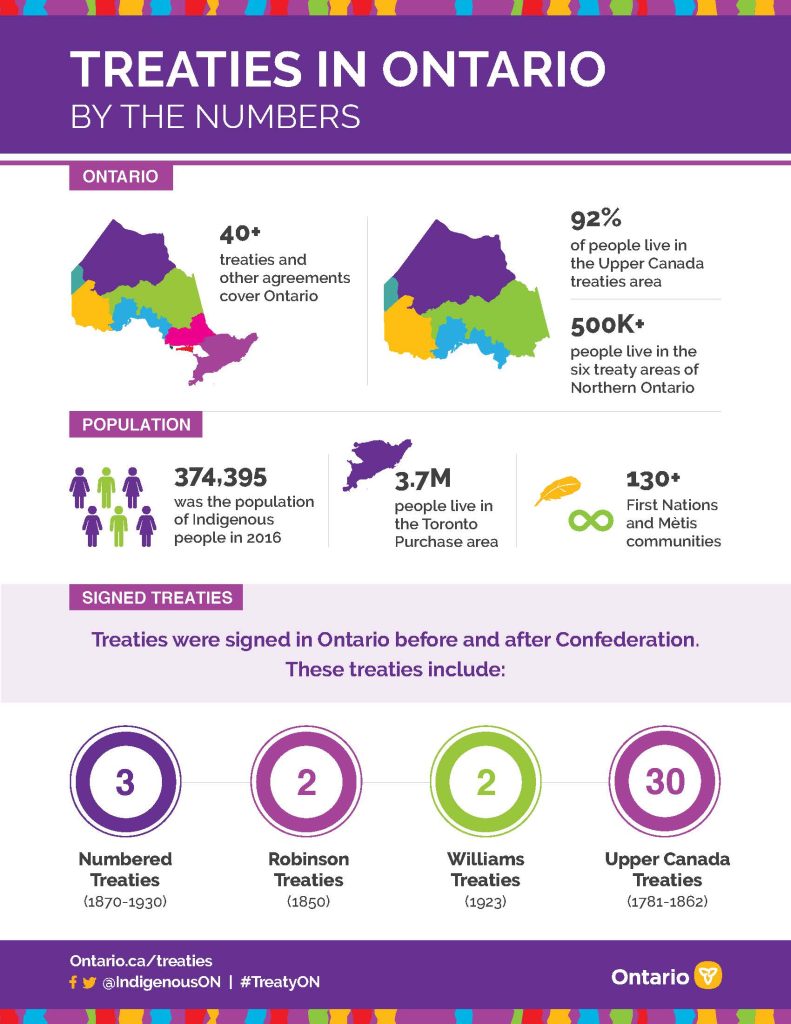
To gain more knowledge of what it means to be a treaty person, see We are all Treaty People below, a video that promotes Treaty Education within the Mi’kma’ki Territory (Nova Scotia).
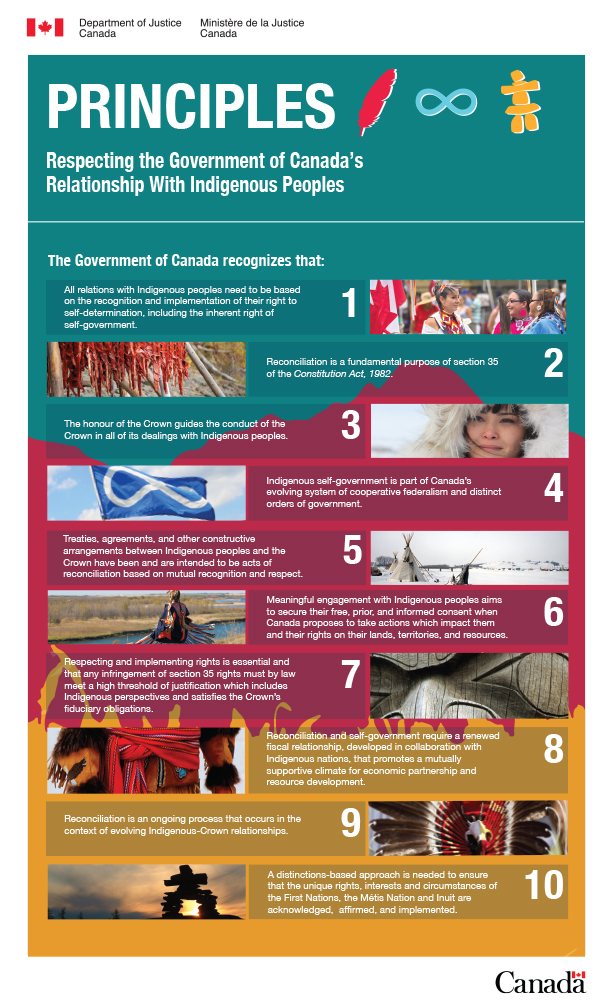
The Government of Canada under the current Trudeau Liberal government has established ten principles respecting the Government of Canada’s relationship with Indigenous peoples. As you read through these principles, consider how well the Government (Crown) is doing in living up to these principles, and what could you be doing to hold the government accountable to upholding these principles?
According to the GOC (2021) “these Principles are a starting point to support efforts to end the denial of Indigenous rights that led to disempowerment and assimilationist policies and practices. They seek to turn the page in an often troubled relationship by advancing fundamental change whereby Indigenous peoples increasingly live in strong and healthy communities with thriving cultures. To achieve this change, it is recognized that Indigenous nations are self-determining, self-governing, increasingly self-sufficient, and rightfully aspire to no longer be marginalized, regulated, and administered under the Indian Act and similar instruments” (para. 6).
When looking at treaties, it’s important to consider the different worldviews of Indigenous Peoples and European settlers. For Indigenous Nations, treaties were viewed as an equal relationship where both nations can live together and share the land. On the other hand, European settler governments didn’t view Indigenous Peoples as equals. They viewed treaties as a way to assimilate and remove Indigenous Peoples from their lands (Historica Canada).
Conclusion
The nation of Canada was founded on patriarchal, monarchist, Christian, white European colonialism. This chapter has presented some of this history and its ongoing impact on people who are First Nations, Métis, and Inuit. While some progress and change is happening, a very long road to reconciliation lies ahead for Canada and Indigenous peoples. In our next chapter, we’ll examine Canada’s path towards reconciliation.
Attributions
This page has been edited and remixed from the following sources. Supplemental information has been provided by Tricia Hylton.
College Libraries Ontario. (n.d.). Maamwi. The Learning Portal. https://tlp-lpa.ca/maamwi
“Skoden” Copyright © 2022 by Seneca College is licensed under a Creative Commons Attribution-NonCommercial-ShareAlike 4.0 International License, except where otherwise noted.
References
CBC News. (2018). How to talk about Indigenous people [Video]. Youtube. https://www.youtube.com/watch?v=XEzjA5RoLv0
Chippewas of Rana First Nation. (2016). Justice Murray Sinclair on the Royal Proclamation of 1763 [Video]. Youtube. https://www.youtube.com/watch?v=dSQsyZDGoX0&t=2s.
Government of Canada. (n.d.). Principles of respecting the Government’s of Canada relationship with Indigenous Peoples. Canada’s System of Justice. https://www.justice.gc.ca/eng/csj-sjc/principles-principes.html.
HistoricaCanada.ca. (n.d.) Treaties in Canada: Education guide. http://education.historicacanada.ca/files/104/Treaties_Printable_Pages.pdf
Johnson, S. (n.d.) Historical primer. Native land digital. https://native-land.ca/resources/teachers-guide/
Ontario.ca. (n.d.). Treaties in Ontario: By the Numbers [Infographic]. First Nations, Inuit and Metis. iao-treaties-in-toronto-infographic-en-2021-03-10.pdf (ontario.ca).
TheFPSChannel. (2021). Treaty education [Video]. Youtube. https://www.youtube.com/watch?v=RElug0TiAZw
TVO Today. (2019). The Indian Act Explained [Video]. Youtube. https://www.youtube.com/watch?v=OhBrq7Ez-rQ
Any good search for information begins with a well defined research process that includes several steps regardless of whether or not you include AI-assisted technologies in the process. Having a clear view of the process as a whole, as depicted in Figure 7.2.1, will help you to efficiently manage your time, resources, and efforts.
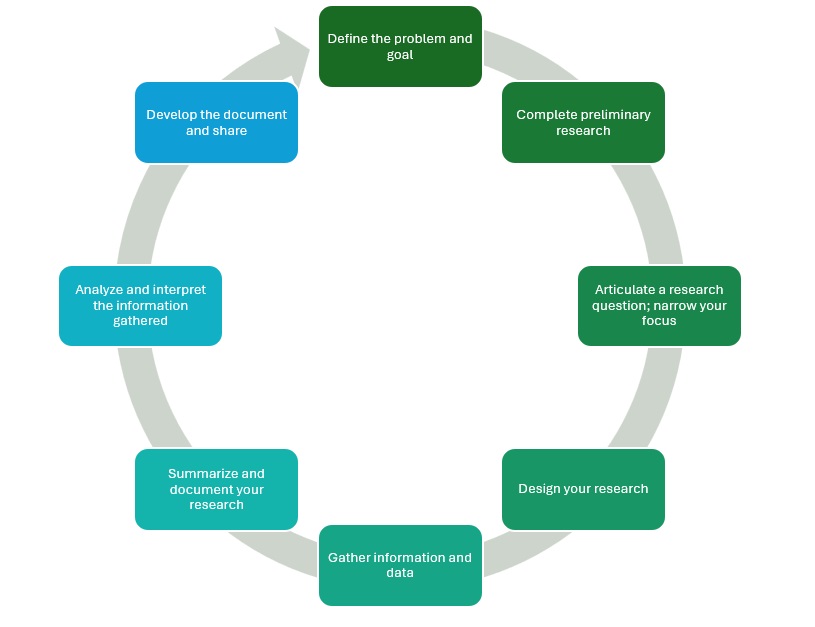
Defining the Problem and Identifying Your Goal
Research is performed typically in pursuit of information that helps to solve a problem, confirm a hypothesis, reveal new information, and the like. That research will only be effective if the challenge or problem is defined to identify the goals for the research and limit the scope of the work to be done. To define the scope, carefully analyze all aspects of the situation at hand in order to identify avenues of investigation: the origin of the problem, how it has evolved, its impact, costs, and any challenges in finding some solutions. Asking the following questions can help you with this scoping task:
- How do you know there is a problem?
- What measurable impacts can you point to?
- What will you need to prove that this is a significant problem?
- Do you have data to show the extent of the “unsatisfactory situation” and how it negatively affects people, the organization, stakeholders, or others?
- What is the expected goal or target that any proposed solution is expected to meet?
- What criteria need to be met in order to have a satisfactory solution?
- Is there a budget limit?
- Is there an expert or someone experienced who can provide insights on the problem?
Figure 7.2.2 provides an overview of five reasons improper scoping happens.

LLMs may be helpful in this analysis phase, but only if specific details about the problem are included in the prompt. Company or client+ confidentiality may not permit you to input such detail into an LLM or other AI application. Rather, consider investigating the problem yourself to acquire an in depth knowledge of the situation while respecting confidentiality.
Conducting Preliminary Research
Before launching into detailed research, it's best to conduct some preliminary research into the work that has already been done by others on the problem. Doing so enables you to get a sense of the major issues surrounding the topic, investigate the best sources for information and data, and determine which experts and reliable sources you would want to consult further. Starting with the most proximal and immediate sources of information within your organization is advisable. Then you can expand your research as the subject matter dictates.
Various AI-assisted research tools exist to help you conduct preliminary research into the topic. Ensure that you choose reliable tools. Overall, LLMs are not as yet reliable because they generate hallucinated, incorrect, or fake information. Be selective in choosing search tools: library search tools and databases such as those found on the Seneca Libraries site are the most reliable and include peer-reviewed texts. Using such tools allows you, the researcher, to explore the topic as you review various materials that come up in your search.
AI research tools can rapidly conduct the research for you. While you will definitely experience a savings in time and effort, you will not develop as integrated a knowledge on the subject as when you are performing the searches yourself. And some tools, such as Perplexity, have proven to be unreliable, so choose your AI search tools after researching them to find out which are the best for the subject matter at hand.
Articulating the Research Question
Articulating a research question helps you to narrow the focus of your research. Research has a tendency to go in all kinds of directions; your research question will anchor your activity. To articulate an effective research question, consider the problem or challenge at hand, the primary potential course of action to solve the issue, and the key research done so far on the subject. You may want use various methods to narrow the focus of your research. Strategies for narrowing and focusing include the following:
- Free–writing: Write for 10 minutes straight without stopping or self-editing.
- Mind-mapping or Concept-mapping: Create a graphic organizer listing ideas and indicating how they are connected. See the section below for more information on concept-mapping in narrowing the focus of research.
- Questioning: What do I already know? What do I need to find out? Use the who, what, where, when, why, how questions to brainstorm.
- Brainstorming: List all ideas without censoring or rejecting any, no matter how seemingly insignificant they might appear at first.
You can use LLMs to help you articulate a research question, but your prompt will have to be specific. Again, ensure that in your prompt you do not share confidential company or client information.
Designing Your Research
Once you have a good understanding of the problem and have some knowledge of the major work already done on the subject, you can now design your research. This process often entails reflecting on your goals, research direction, materials and resources, expertise, budget, and gaps in knowledge. At this stage, creating a project plan for your work would help you delineate and clarify key aspects of the research activity:
- Goal(s) and objectives
- Constraints
- Anticipated impediments or challenges
- Expertise at hand and to be resourced
- Budget
- Task breakdown
- Timeline for tasks and project completion
- Equipment, tools, safety protocols and supplies, materials required
- Documentation methods, tracking, and storage plans
- Legal, regulatory, and policy considerations and guidelines
- Geographical, demographic, and technological considerations
At this stage, you should be making decisions on the types of materials and resources you will be using, including the moments when you will integrate the use of LLMs and other AI-assisted search technologies. Determining which types of technologies will be included and excluded in the research process should be a deliberate part of the design process and influenced by ethical research practices, organizational policies, and confidentiality.
LLMs can be helpful in drafting a research plan. By providing a detailed description of your goals, plans, constraints, etc. in the prompt, the LLM will provide you with a draft0 1planning document that you can refine to suit your specific purpose.
Gathering Information and Data
Anyone with a sense of curiosity and a thirst for knowledge will know that research can quickly expand as you investigate one excellent resource after another. Here are a few strategies to help you gather information and data while being mindful of your goal:
- Select search tools and methods that are known to have a minimum degree of bias and inaccuracy. If you are unsure, do a brief test with the tool you are using to ensure fair collection of information.
- Organize your search by creating a list of key topic areas and link each with the methods that are most appropriate for data collection.
- Determine whether you need qualitative and/or quantitative information: Doing so will help you plan your methods. For example, to obtain qualitative information, you would most likely be using surveys, observation, and interviews.
- Be discriminating: Select quality materials that will help to create a balanced discussion of the subject. Investigating information that challenges your perspective and assumptions in addition to materials that support them will enable you to create a strong argument.
- Employ a range of materials to solidify your credibility.
- Discard sources that obviously are biased, inaccurate, and based on flimsy data.
- Keep a journal that records your daily activity and reflections on the direction of the research so you can keep track of your progress.
Information on using various traditional and non-traditional sources of information can be found in Chapter 7.3 Finding and Evaluating Research Information.
Summarizing and Documenting Your Sources
As you are performing your research, record your sources and summarize key articles. Doing so throughout the research process will help you to save time, gain depth knowledge of the subject matter, and envision the arguments you will use in your reporting. The manner in which you conduct your search will influence just how deeply you will become familiar with the subject matter. If you search and summarize the key articles yourself, you will have much greater knowledge than if you use AI applications.
AI search tools like Elicit are convenient, however. They will use a research question to quickly complete searches for papers published through Semantic Scholar. This tool will aggregate sources, summarize articles, and pull key information from them. In addition, tools like Zotero can be used to organize and share information gathered through the internet. It's automation features will also create annotations, as well as in text citations and bibliographies inside Word and Google documents. Whatever tools you use to gather and document the information, remember that you will be responsible for the information you include in your reporting, so you must ensure that the summarized information is accurate and unbiased.
Tracking the progress of your research from the outset is an important time saver. With a record of your work, you can see the information you have already viewed and can avoid the duplication of your efforts. In addition, the record of information allows you to efficiently cite and document your work as you draft your report at the end of the process. If working with others, they will be able to see the work that has been done, thus avoiding duplication by team members.
Analyzing and Interpreting the Information
Effective research will give you a considerable amount of useable information. Now what do you do with it? Once you have gathered your research, organize it into topic areas if you have not already done so in the gathering phase. Sort and select the information that you will be including in your discussion of your findings. At this point, you may want to use the following strategies to organize the materials:
- Categorize and classify: Creating categories and classifying key information will help you to organize complex data into meaningful groups. Doing so will also reveal patterns and enable clearer comparisons. For example, you could classify an organization's sustainability initiatives as strong, significant, moderate, minimal, or absent.
- Compare and contrast: Comparing and contrasting can improve the understanding of the situation at hand versus what it could or should be. Using a methodical approach that includes parallel criteria for the analysis will give this strategy more validity. For example, you could compare data relating to website traffic and usage in the past year to those gathered over the past three to reveal important trends in usage.
- Describe: Describing a situation or object helps you to clarify and define it. Using specific detail, here, is essential. Draw on physical and other detail, chronologies, locations, and other type of specifics to facilitate understanding by your audience. For example, describing how a marketing initiative did not meet expectations allows the audience to understand the initial problem that is triggering the investigation.
- Analyze and Evaluate: Using your critical thinking abilities to analyze and evaluate the information gathered will add depth and meaning to the discussion of your findings. Technical analyses and evaluations can take many forms and specific techniques can be employed to facilitate the process: For example, take a look at this Guide to Technical Analysis for Engineering Projects, which emphasizes key analytical approaches that also carry over to non-engineering projects. Quoted below are their Key Components of Technical Analysis (NERAC, n.d.):
-
Feasibility Studies: Assessing the viability of proposed solutions in meeting project goals.
-
System Design Reviews: Evaluating the design of systems for efficiency, reliability, and adherence to standards.
-
Performance Simulations: Using computer models to simulate system performance under various conditions.
-
Material Analysis: Analyzing materials for suitability in specific applications, considering factors like strength, durability, and cost.
-
Risk Assessment: Identifying potential risks to project success and proposing mitigation strategies. (NERAC, n.d.)
-
- Predict: Recognizing patterns in the information and data you have gathered and analyzed along with making inferences will enable you to make educated predictions on the direction or trend in which a problem will evolve as well as how a potential solution will work out. For example, Uber uses data on probable increases in ridership depending on current contexts or situations to determine the prices of fares.
Developing Your Document
You are now ready to begin working on developing your reporting instrument, be it an infographic, presentation, or other type of report—informal or formal. To begin the process ask yourself the following questions:
- Who is your primary audience? Who else might have an interest in this research?
- What degree of technical knowledge and understanding will this audience have?
- What is the specific outcome you want this document or project to achieve? What do you want your readers to do, think, or decide after becoming aware of your findings?
- Who are the people who will be affected by this project? Who are the stakeholders?
- What is the best format to use to present these findings to these readers? (What format or specific information have they requested?)
You will find detailed information on how to develop technical reports and presentations in the coming chapters of this text.
Knowledge Check
Using Concept Mapping to Narrow Your Research
In industry, projects often focus on opportunities—whether a challenge or problem is evident or an offer has been made. Clearly defining the need in as open-ended a way as is feasible, determining the desired outcome or goal, and coming up with ideas for an approach that will enable you to reach that goal are some determining factors for the direction that your research will take.
Your research process should be focused on providing support for the basic premise of your research question (is this idea feasible?) and prove your hypothesis or possible solution (will it be effective/beneficial?). You might do this by showing that similar ideas have been implemented and/or researched in other areas, or that the ideas you are presenting are based on sound evidence. Collecting your own primary data (such as a questionnaire or site visit) may also help show how your ideas are feasible.
The first step in most projects is figuring out what you already know and what you don't know. This will help to direct the thrust of your research efforts. Without this basic contextual work, it's difficult to work your way to finding relevant sources that can help you apply theories, analyze information and data from sources, and synthesize them into your own argument or recommendations. Concept mapping is one useful way to develop a direction for your work. AI-enhanced tools are now available to facilitate the process of creating concept maps. See Mural for example.
Figure 7.2.3 shows an approach to concept mapping that focuses on a specific problem. The mapping effort is focused on the general idea and finding areas of potential investigation. A good focus for a paper or project will likely be 3-4 nodes away from the central problem box.
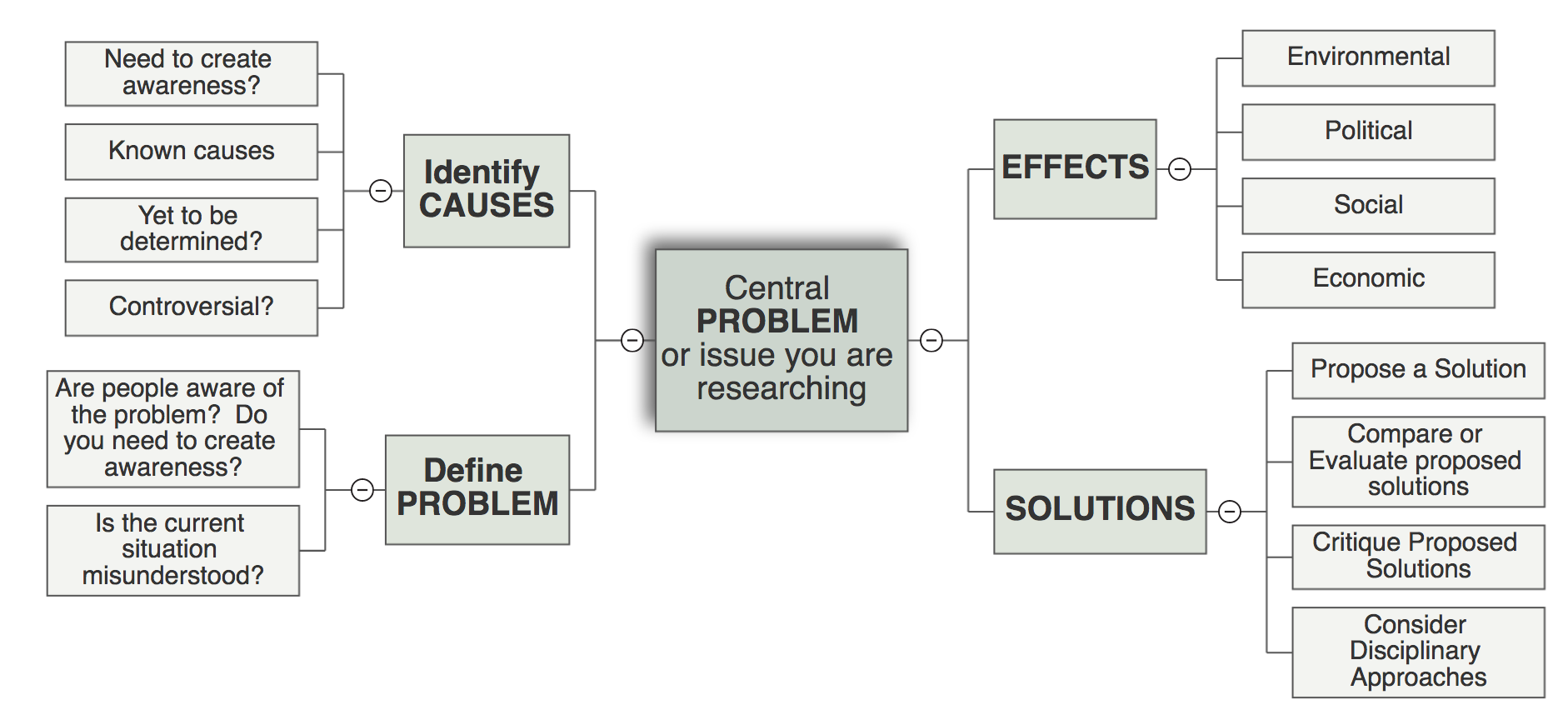
You generally cannot cover all issues in one paper or project. So your task is to narrow your focus so that you can research a specific aspect of the topic in-depth. Choose one specific focus (proposing a solution), and consider what other aspects must be included (defining the problem; choosing a specific demographic or geographical area to focus on; using criteria to narrow potential solutions).
As an example, consider the issue of Climate Change and how it might fit into each of these “narrowing your focus” categories. A problem-solving approach offers many ways to narrow your focus. Try creating a concept map such as shown in Figure 7.2.4 to get a sense of the many ways you might approach your topic, and then narrow down your focus to one of those approaches. This will help you think of keywords to use in your search for sources. The more you brainstorm, the more potential keywords and synonyms you can come up with. The “mind map” below shows various ways to consider the larger context of your problem and find a specific area to focus on.
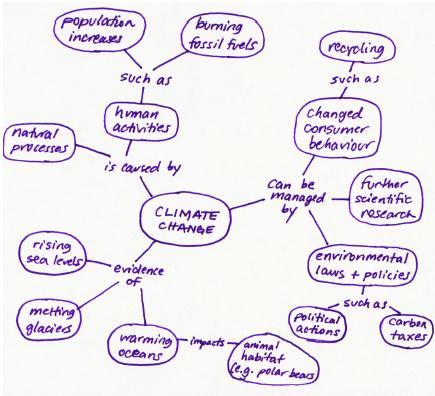
This kind of “graphic brainstorming” can help you visualize the connections between the various ways your topic can be approached. You can ask questions such as how? why? who? to further extend this exploration. Your goal here is to narrow your focus to one “bubble” (that is perhaps 3 or 4 nodes away from your central topic node) that can afford a promising topic while limiting the scope to something you can accomplish in the given time frame and assignment specifications (word count, research requirement, goal, resources, budget, etc.). For brief instructions on how to use a concept map, view the following video found through The Learning Portal: How to use concept mapping (2016).
LLMs can become efficient partners in helping researchers to brainstorm ideas and narrow the focus of investigations. See the example below:
Asking the LLM to Help Narrow the Research Focus
Example using Copilot on January 15, 2025.
Prompt: I'm trying to narrow the focus of my research on the topic of climate change specific to Toronto. I'm interested in investigating the impact on urban in contrast to suburban areas—focusing on residential costs. Can you suggest some topic areas I could investigate? Include references.
Copilot Output
Here are some topic areas you could investigate, along with references to support your research:
- Urban Heat Islands
- Compare temperature variations between urban and suburban areas.
- Investigate the impact of heat islands on energy consumption and cooling costs.
- Reference: The City of Toronto's report on climate impacts highlights the increasing number of extreme heat days and their effects on urban areas[1].
- Flooding and Stormwater Management
- Assess the effectiveness of urban vs. suburban stormwater management systems.
- Examine the costs associated with flood damage and mitigation in different areas.
- Reference: Toronto's climate adaptation strategies emphasize the need for improved stormwater management to cope with increased precipitation[1].
- Air Quality and Health Costs
- Compare air quality levels in urban and suburban areas.
- Investigate the health-related costs due to poor air quality and extreme weather events.
- Reference: Research shows that low-income communities in Toronto face greater exposure to health risks like polluted air and extreme heat[2].
- Housing and Infrastructure Resilience
- Evaluate the resilience of housing and infrastructure to climate impacts in urban vs. suburban settings.
- Analyze the costs of retrofitting buildings to withstand extreme weather.
- Reference: The City of Toronto's climate readiness updates discuss the financial risks and costs of adapting infrastructure to climate change[3].
- Green Spaces and Tree Canopy
- Compare the availability and impact of green spaces in urban and suburban areas.
- Investigate the role of green spaces in mitigating climate impacts and their influence on property values.
- Reference: Lack of public green space and tree canopy in certain Toronto neighbourhoods can worsen air quality and increase health risks[2].
- Socioeconomic Disparities
- Examine how climate change impacts vary across different socioeconomic groups in urban and suburban areas.
- Investigate the costs of climate adaptation measures for low-income households.
- Reference: Vulnerable groups in Toronto need more support to cope with poor air quality and other climate impacts[2].
- Energy Efficiency and Renewable Energy Adoption
- Compare the adoption rates of energy-efficient technologies and renewable energy in urban vs. suburban areas.
- Analyze the cost savings and incentives associated with these technologies.
- Reference: The City of Toronto's climate action strategy includes measures to reduce greenhouse gas emissions and promote energy efficiency[4].
- Transportation and Commuting Costs
- Investigate the impact of climate change on transportation infrastructure and commuting patterns.
- Compare the costs of commuting and transportation-related emissions in urban and suburban areas.
- Reference: Toronto's climate action initiatives include investments in public transit and electric vehicle infrastructure to reduce emissions[5].
These topics should provide a comprehensive understanding of how climate change impacts urban and suburban areas differently, especially in terms of residential costs. If you need more detailed information on any of these areas, feel free to ask!
References
Note: Once output is produced, it is your responsibility to corroborate all references and ensure accuracy. Then you can use this list as a launch for further ideation.
Clearly, no one can solve the problem of climate change in one paper or project: No reasonable instructor or employer would expect anyone to do so. However, you might be asked to explore effective ways to analyze the costs of carbon emissions in a specific industry in a given period of time and/or geographical region. Or you might investigate whether a particular form of alternative energy would be effective in a particular situation. Even then, you would have to consider various tactics: Would you recommend changing a policy or law to try to address the causes of the problem? Providing incentives to industry or consumers? Evaluating a currently proposed solution?
Researching what other people working in this field have studied and written about can help you refine your focus, build your own knowledge on the subject, and choose how you want to participate in this "conversation." The ultimate aim is to narrow your topic enough to provide a specific question to guide your research and identify keywords and terminology related to your topic. A good research question should be somewhat open-ended; that is, the answer should not be a simple “yes” or “no.” The focus of your research question should allow you to provide a comprehensive answer that takes context into careful consideration.
Defining the Problem
Several years ago, research focused on defining the problem of climate change, and convincing the general public and government officials that a problem exists and is serious enough that we must start working on solutions immediately. Now, the vast majority of scientists and researchers accept that a problem exists: The climate is indeed warming and this is a problem. Ongoing research might determine ways to convince people and companies who are not yet convinced and ways to motivate people to take the problem seriously enough to consider changing their behaviour or policies.
Identifying Causes
In the last few years, there has been controversy over what the CAUSES of this problem are. Is climate change a naturally occurring, cyclical phenomenon or “anthropogenic” (human-caused)? Research has convinced most people that climate change is anthropogenic: that human consumption of fossil fuels is the main cause of climate change.
Research is ongoing about the kinds of technological activities (fracking, building dams, etc.) that might be contributing more or less to climate change. Research might also consider effective ways to modify human behaviour in order to slow down those causes.
Identifying Effects
Much research currently explores the effects of climate change, and even how we can determine what specific effects can be the direct result of climate change. This can be done from different disciplinary approaches. For example:
-
Social justice research explores how certain groups of people (based on geography or socio-economic status) are impacted more severely than others.
-
Political theorists may explore how different government types create different kinds of policies in response to the problem.
-
In economics, researchers might try to predict how climate change may affect certain aspects of the global or local markets.
-
In psychology, researchers might explore how people respond to the idea of climate change (e.g., stress, depression, motivation, etc.).
-
Environmental researchers have numerous possible topics! For example, how is climate change affecting a particular species in a particular region? What impact might this have on the local ecology or human society? How should building standards in coastal areas be adapted for climate change?
Exploring Solutions
Research questions—such as “Are Carbon Taxes and Caps an Effective Way to Reduce GHS Emissions?” and “Will Developed Nations' Taxes Help Developing Countries Create Low Carbon Technologies?”—analyze the effectiveness of proposed or currently implemented solutions. Some research compares the effectiveness of two possible solutions. Some propose new solutions (Tidal Power or AI controlled systems to enhance efficiency). Some might propose implementation of previous solutions in new contexts.
As you can see, research will be needed no matter what the focus or approach is adopted in working on this type of project.
Knowledge Check
Using an organized and deliberate approach to researching information will help you save time and reveal information that you can use to your purpose. Following the steps in the research process and using tools like concept-mapping will help to reveal avenues of pursuit and the methods by which to best follow them.
References
Founder's Blog. (n.d.). Why improper scoping happens [Infographic]. MindBowser. https://www.mindbowser.com/how-to-define-the-project-scope-the-foolproof-way/
Malau-Aduli, B. and Alele, F. (2023). 2.1 Research Process – An Introduction to Research Methods for Undergraduate Health Profession Students
NERAC. (n.d.). A Guide to Technical Analysis for Complex Engineering Projects - Nerac
The Learning Portal. (2016, September 1). How to use concept mapping [Video]. YouTube. https://youtu.be/PwADmiHGWWI
University of Victoria Libraries. (n.d.). [Concept Map]. http://libguides.uvic.ca/c.php?g=256802&p=3906769
Westford Uni-Online. (2024). 10 Essential Business Analysis Techniques Every Professional Should Know - Westford Online

